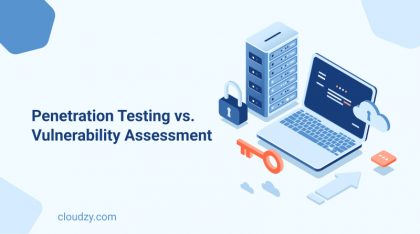Are you concerned about the safety of your digital assets in our hyper-connected world? In today’s age of constant connectivity, securing your online presence is non-negotiable. Filthy hackers and potential attacks are always lurking in the shadows. That’s why you need to know about Network Penetration Testing steps as a great solution in preventing cyber threats. Think of this as a digital detective that meticulously inspects your network’s defenses to find vulnerabilities before attackers can. Instead of reacting to attacks after the fact, network penetration testing takes a proactive approach and showcases the vulnerabilities before a major crisis. By taking penetration testing seriously, you prioritize protection over finding a cure.
This guide will explain network penetration testing without overwhelming you with tech jargon. Whether you’re reading this for your network engineering course or you are a server admin, you can learn something here. So, let’s dive in!
What Is Network Penetration Testing
Network Penetration Testing, or network pentesting, essentially functions as an ethical hacker’s contribution to strengthening digital security. The primary objective is to simulate real-world cyber threats and identify potential weaknesses before they are exploited by harmful entities. Adopting this proactive strategy is an intelligent method to preemptively tackle issues instead of resolving them post-occurrence. Here are the steps in network security testing:
1. Target Identification
The first step in network pentesting is to identify the target. Network pentesting agents will look for specific systems, devices, and services that need to be tested. Everything from routers, switches, and servers to applications can be included in the target identification.
2. Data Collection
Now that the target scope is clear, network pentesting agents will gather information, including IP addresses, domain names, network configurations, and so on. This information is crucial since it gives testers a clear understanding of the network’s layout and potential entry points for attacks.
3. Vulnerability Analysis
Based on the target network and the information collected, network pentesting agents analyze system vulnerability to find potential security weaknesses. In this step of network security pentesting, tasks like automated scanning, manual inspection, and identifying vulnerabilities in network devices, operating systems, and applications are included.
4. Exploitation
When vulnerabilities and entry points are identified, network pentesting agents will exploit them. Doing so will give them the knowledge of how hard or easy it is to gain unauthorized access to sensitive data. Exploitation can be done with a number of techniques, including brute-force attacks or social engineering tactics.
5. Deep Escalation
Once network security testing agents gain initial access to critical systems, they try to escalate into the network to gain deeper access. This move will include actions like exploiting additional vulnerabilities, misconfigurations, or weaknesses in access controls.
6. Reporting
This is the most important step in network security testing. Simultaneously happening throughout exploitation and deep escalation, testers will document their discoveries, including the vulnerabilities, techniques they used during exploitation, how far into the network they accessed, and the potential impact on the network’s security. They will then create a detailed report from the documentation outlining the discoveries, solutions, and strategies on how to improve the network’s overall security.
7. Post-Testing Actions
After the network security testing process is over, organizations engage in post-testing activities. These actions usually include implementing recommended security patches, configuring security controls, and training employees to implement security practices and improve overall network security.
Exploring Different Types of Penetration Testing
Network pentesting includes many different types depending on the organization’s requirement and network pentesting sensitivity. There are different categories, types, and methods organizations can use for network security testing. There are two types of operations you have to consider. Network pentesting can be done automatically or manually:
Automated Network Pentesting
Automated testing is the best solution for repetitive and regular network security testing tasks. It is tool-based and is an efficient solution for identifying common vulnerabilities. It’s cost-effective, fast, and can quickly cover a wide range of systems and applications.
Automated testing has one important disadvantage which is its limitations. It may not identify complex vulnerabilities or logical errors that require human intuition and expertise.
Manual Network Pentesting
Manual testing is suitable for facing complex security issues and requiring a thorough assessment. It’s done manually by human testers and is expert-driven. It can be customized based on unique aspects of network and applications, can cover complex vulnerabilities automated testing might miss, and provides a more thorough analysis of the security controls.
One disadvantage of manual network security testing is that it’s much more time-consuming and resource-intensive compared to automated testing.
Methods of Penetration Testing
Regardless of whether penetration testing is conducted manually or automatically, there are 6 different methods:
Black Box Testing
Back box, also known as external pentest is akin to a tester being blindfolded, having no previous information about the system being tested. It mimics an outsider’s attempt to find vulnerabilities without any insider knowledge. External pentesting is effective for uncovering external flaws that could be targeted by attackers. External pentest agents examine flaws and vulnerabilities they locate while screening your public information, such as company emails or websites.
White Box Testing
In contrast to black box testing, white box testing, aka internal pentest, involves full transparency and access to the system’s internals. Internal testing agents are equipped with comprehensive knowledge of the network architecture, source code, and detailed system information. Internal pentesting focuses on detecting vulnerabilities from within the system, offering an internal viewpoint. Internal pentest’s main goal is to identify vulnerabilities an ill-intended employee might use to access valuable company data.
Gray Box Testing
Gray box testing strikes a balance between black box and white box methods. Testers use this method when they have partial knowledge of the system. There are some attack scenarios in which the attacker has some insider help and information. This method is trying to mimic those exact situations where the attacker is armed with some internal information, as well as great knowledge on how to exploit the system from outside.
Targeted Penetration Test
A targeted penetration test functions much like a precision-guided missile, honing in on a particular area within an organization’s infrastructure to identify potential security flaws. For instance, consider a financial institution aiming to evaluate the security of its online banking application. In such a targeted test, the penetration tester would concentrate solely on this application, examining it for vulnerabilities, possible weaknesses, and potential methods of attack. This focused approach enables organizations to ensure that vital elements of their security systems are functioning effectively.
Blind Penetration Test
In a blind penetration test, the tester operates with limited information about the target system, just like a detective solving a mystery with only a few clues. Imagine a company hires a blind tester to assess its network security. The tester knows the company’s name but has no further details about the network’s structure, security measures, or vulnerabilities. This simulates a scenario where an attacker with minimal knowledge attempts to infiltrate the network. The goal here is to uncover vulnerabilities that might be used by opportunistic cybercriminals. Blind penetration testing and black box testing are often used interchangeably, but they have subtle differences.
Double-Blind Test
A double-blind penetration test takes the challenge to the next level by creating a scenario where both the organization’s security team and the penetration tester have limited information. Picture a high-stakes security assessment for a government agency. Neither the security team nor the tester knows when the test will happen. This way, the test can mimic the unpredictability of real-world cyber threats. The tester attempts to infiltrate the network without any insider knowledge while the organization’s security team scrambles to detect and respond to the intrusion, testing the effectiveness of their incident response capabilities.
Grasping the nuances of these testing methods and their practical uses allows organizations to select the most suitable approach for evaluating their security stance. This understanding is key in bolstering their capability to effectively counteract cyber threats.

How Does Network Penetration Testing Work?
Penetration testing follows a systematic approach to detect vulnerabilities and assess the security of a network. The process typically consists of several phases, each playing an important role in ensuring comprehensive testing. Let’s delve into the five key phases of network penetration testing:
1. Planning and Reconnaissance
- The penetration tester starts by working with the client to determine the test’s scope and goals.
- Extensive research is conducted to collect data about the targeted system or network.
- The aim is to pinpoint possible access points and vulnerabilities before the actual testing starts.
2. Scanning and Enumeration
- Following the preparation, the analysis phase commences, utilizing a range of tools to examine the target network for open ports, services, and potential security flaws.
- Discovery, or enumeration, involves active engagement with the network to extract more details like system specifications, user profiles, and network setups.
- This stage focuses on developing a detailed layout of the network’s architecture.
3. Gaining Access
- This is where the penetration tester attempts to exploit the identified vulnerabilities to gain unauthorized access to the target systems or applications.
- Techniques such as brute-force attacks, exploitation of software vulnerabilities, or social engineering may be employed.
- The objective is to mimic the actions of a real attacker trying to breach the network’s defenses.
4. Maintaining Access
- After initial access is achieved, the penetration tester maintains control over the compromised systems.
- This phase simulates the actions of an attacker who has successfully infiltrated the network and is trying to maintain persistence.
- It involves tasks like setting up backdoors or creating user accounts to ensure continued access.
5. Analysis and Reporting
- Once testing is complete, the penetration tester thoroughly analyzes the findings and assesses the impact of the vulnerabilities discovered.
- A detailed report is generated, outlining the vulnerabilities, their potential impact, and recommendations for remediation.
- The report is a valuable resource for the client to prioritize and address security weaknesses effectively.

The Value of Network Penetration Testing for Network Engineers and Server Admins
In the world of network engineering and server administration, staying one step ahead of potential security threats is not just a good practice; it’s an absolute necessity. Network penetration testing is a valuable tool that can be a game-changer for professionals in these roles. Let’s dive into the reasons why network penetration testing should be a part of your toolkit:
Enhancing Security Posture
Network penetration testing is like a security health check for your network. By proactively uncovering the potential issues, you can take the necessary steps to patch them and strengthen your network’s security defenses. It’s like having a regular check-up with your doctor to catch potential health problems early on.
Compliance and Regulatory Benefits
Many industries are subject to stringent compliance regulations, which require periodic security assessments. Network penetration testing can help you meet these compliance requirements by providing documented evidence of your security efforts. Whether it’s HIPAA, PCI DSS, or any other regulatory framework, pen testing can be useful when it comes to compliance.
Proactive Approach to Threat Mitigation
Relying on the anticipation of a security breach is a precarious strategy. Network penetration testing adopts a proactive stance toward threat mitigation. Through the simulation of real-world attack scenarios, you can detect vulnerabilities ahead of cybercriminals. This proactive approach enables timely remediation of identified issues and the implementation of robust security measures to avert potential breaches.
For network engineers and server admins, understanding the intricacies of network penetration testing is crucial in fortifying your systems against potential threats. But security doesn’t end there. To truly safeguard your digital assets, comprehensive cybersecurity asset management is equally essential. Dive into our blog post on CSAM to learn how you can efficiently track, manage, and protect all your IT assets, ensuring a robust defense against evolving cyber threats.
Network engineers and server administrators should prioritize penetration testing because it serves as a clandestine advantage in the constant struggle to safeguard their networks, maintain regulatory compliance, and outpace malicious actors.
To Wrap Up
In this guide, I aimed to emphasize the significance of proactive security measures. Network penetration testing transcends being a singular assessment; it constitutes a continuous dedication to fostering a more secure digital environment. Armed with the appropriate knowledge and tools, you can confront the challenges of today’s interconnected landscape with confidence.
FAQ
What is the main goal of Network Penetration Testing?
The main goal of network penetration testing is to proactively identify vulnerabilities and weaknesses in your network infrastructure, applications, and systems before cybercriminals can exploit them. It helps organizations assess their security level and take necessary steps to strengthen their system.
How often should we conduct Network Penetration Testing?
How often network penetration testing occurs hinges on various factors such as the industry of the organization, regulatory obligations, and the pace of system modifications. As a general guideline, it is recommended to conduct testing on a regular basis, ideally at least annually, and whenever substantial alterations or updates are implemented in your network or applications.




